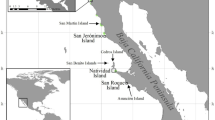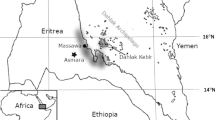Abstract
The Cape fur seal, Arctocephalus pusillus pusillus is distributed along the southern African coastline from northern Namibia to the south-east coast of South Africa. The species has been impacted by sealing operations since the 1600s, and historical records suggest that the taxon experienced a bottleneck prior to the 20th century. Mitochondrial DNA control region sequences were generated for 106 individuals belonging to six breeding colonies. Haplotype diversity was found to be high (0.975±0.014) whereas levels of nucleotide diversity were much lower compared to other seal species (0.011±0.006). An analysis of molecular variance indicated that the largest percentage of haplotype diversity is distributed within colonies rather than among them. This could be attributed to either extensive gene flow among colonies, a lack of substantial female site philopatry, or incomplete lineage sorting of haplotypes. Mismatch distribution and Fu’s F S test indicated that the population has experienced a historical population expansion probably between c. 37,000–18,000 YBP and this date coincides very well with the height of the last glacial maximum when food resources were abundant in the South Atlantic. These results also suggest that the recent sealing-induced bottleneck did not have a profound influence on the haplotype diversity and a historical bottleneck prior to a demographic expansion may have been severe enough to reduce nucleotide diversity substantially.



Similar content being viewed by others
References
Bernardi G, Fain SR, Gallo-Reynoso JP, Figueroa-Carranza AL, Le Boeuf BJ (1998) Genetic variability in Guadalupe fur seals. J Hered 89:301–305
Brunner S, Shaughnessy PD, Bryden MM (2002) Geographic variation in scull characters of fur seals and sea lions (family Otariidae). Austr J Zool 50:415–438
Butterworth DS, Punt AE, Oosthuizen WH, Wickens PA (1995) The effects of future consumption by the Cape fur seal on catches and catch rates of the Cape hakes. 3. Modelling the dynamics of the Cape fur seal Arctocephalus pusillus pusillus. S Afr J Mar Sci 16:161–183
Fu Y-X (1997) Statistical tests of neutrality of mutations against population growth, hitchhiking and background selection. Genetics 147:915–925
Gerber LR, Hillborn R (2001) Catastrophic events and recovery from low densities in populations of otariids: implications for risk of extinction. Mamm Rev 31:131–150
Goldsworthy S, Francis J, Boness D, Fleischer R (2000) Variation in the mitochondrial control region in the Juan Fernández fur seal (Arctocephalus phillippii). J Hered 91:371–377
Harpending HC (1994) Signature of ancient population growth in a low-resolution mitochondrial DNA mismatch distribution. Hum Biol 66:591–600
Harpending HC, Batzer MA, Gurven M, Jorde LB, Rogers AR, Sherry ST (1998) Genetic traces of ancient demography. Proc Natl Acad Sci USA 95:1961–1967
Hoelzel AR (1999) Impact of population bottlenecks on genetic variation and the importance of life-history; a case study of the northern elephant seal. Biol J Linn Soc 68:23–39
Kerley GIH (1983) Record for the Cape fur seal Arctocephalus pusillus pusillus from subantarctic Marion Island. S A J Zool 18:139–140
King JE (1983) Seals of the world. Oxford University Press, Oxford, pp 16–19, 51–54
Kocher TD, Thomas WK, Meyer A, Edwards SV, Paabo S, Villablanca FX, Wilson AC (1989) Dynamics of mitochondrial DNA evolution in animals: amplification and sequencing with conserved primers. Proc Natl Acad Sci USA 86:6196–6200
Lento GM, Haddon M, Chambers GK, Baker CS (1997) Genetic variation of Southern Hemisphere fur seals (Arctocephalus spp.): investigation of population structure and species identity. J Hered 88:202–208
Martin JH (1990) Glacial-interglacial CO2 change: the iron hypothesis. Paleoceanography 5:1–13
Oosthuizen WH (1991) General movements of South African (Cape) fur seals Arctocephalus pusillus pusillus from analysis of recoveries of tagged animals. S A J Mar Sci 11:21–29
Oppo DW, Horowitz M (2000) Glacial deep water geometry: South Atlantic benthic foraminiferal Cd/Ca and δ13C evidence. Paleoceanography 15:147–160
Rand RW (1959) The Cape fur seal (Arctocephalus pusillus): distribution, abundance and feeding habits off the south western coast of the Cape province. Invest Rep Div Fish SA 34:75
Repenning CA, Peterson RS, Hubbs CL (1971) Contributions to the systematics of the southern fur seals with particular reference to the Juan Fernandez and Guadalupe species. In: Burt WH (ed) Antarctic pinnipedia. American Geophysical union, Washington DC, pp 1–52
Rogers AR, Harpending H (1992) Population growth makes waves in the distribution of pairwise genetic differences. Mol Biol Evol 9:552–569
Sambrook J, Fritsch EF, Maniatis T (1989) Molecular cloning: a laboratory manual, 2nd edn. Cold Spring Harbor Laboratory Press, New York
Schneider S, Roessli D, Excoffier L (2000) Arlequin ver. 2.000: A software for population genetics data analysis. Genetics and Biometry Laboratory, University of Geneva, Switzerland
Severinghaus JP, Brook EJ (1999) Abrupt climate change at the end of the last glacial period inferred from trapped air in polar ice. Science 286:930–934
Shaughnessy PD (1984) Historical population levels of seals and seabirds on islands off Southern Africa, with special reference to Seal Island, False Bay. Invest Rep Sea Fish Research Inst SA 127:61
Slade RW, Moritz C, Hoelzel AR, Burton HR (1998) Molecular population genetics of the southern elephant seal Mirounga leonina. Genetics 149:1945–57
Slade RW, Moritz C, Heideman A (1994) Multiple nuclear-gene phylogenies: application to pinnipeds and comparison with a mitochondrial DNA gene phylogeny. Mol Biol Evol 11:341–356
Slatkin M (1985) Gene flow in natural populations. Ann Rev Ecol Syst 16:393–430
Swofford DL (2002) PAUP* Phylogeny analysis using parsimony (*and other methods), version 4. 0b10. Sinauer Association, Inc., Sutherland, MA
Thibault M (1999) Sighting of a South African fur seal on a beach in south-western Gabon. A J Ecol 37:119–120
Weber DS, Stewart BS, Lehman N. (2004) Genetic consequences of a severe population bottleneck in the Guadalupe fur seal (Arctocephalus townsendi). J Hered 95:144–53
Wickens P, York AE (1997) Comparative population dynamics of fur seals. Mar Mam Sci 13:241–292
Wynen LP, Goldsworthy SD, Guinet C, Bester MN, Boyd IL, Gjertz I, Hofmeyr GJG, White RWG, Slade PR (2000) Post-sealing genetic variation and population structure of two species of fur seal (Arctocephalus gazella and A. tropicalis). Mol Ecol 9:299–314
Yokoyama Y, Lambeck K, Deckker PD, Johnston P, Fifield LK (2000) Timing of the last glacial maximum from observed sea-level minima. Nature 406:713–716
Wynen LP, Goldsworthy SD, Insley SJ, et al (2001) Phylogenetic relationships wihin the eared seals (Otariidae: Carnivora): implications for the historical biogeography of the family. Mol Phylogenet Evol 21:270–284
Acknowledgements
Stellenbosch University and South African National Research Foundation (GUN 2053617) for funding the molecular work. MCM and the BENEFIT Programme provided funding for the collection of samples. The following persons assist with the collection of the material: S Swanson, N Mukapuli, D Kotze, E Olsen, M Mauritzen, G Sikute, K Tangeni and D Reynolds.
Author information
Authors and Affiliations
Corresponding author
Additional information
Communicated by P. W. Sammarco, Chauvin
Rights and permissions
About this article
Cite this article
Matthee, C., Fourie, F., Oosthuizen, W. et al. Mitochondrial DNA sequence data of the Cape fur seal (Arctocephalus pusillus pusillus) suggest that population numbers may be affected by climatic shifts. Marine Biology 148, 899–905 (2006). https://doi.org/10.1007/s00227-005-0121-3
Received:
Accepted:
Published:
Issue Date:
DOI: https://doi.org/10.1007/s00227-005-0121-3




